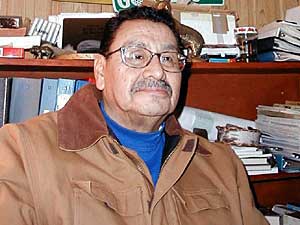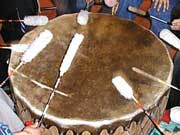Part 7: The healing spirit
August 20, 2003
 |
| Larry Aitken is a Native healer on the White Earth Reservation. He says there are hundreds of plants found in the forest that can be used for medicine. (MPR Photo/Tom Robertson) |
Leech Lake Reservation — American Indians believe healing is part of all spiritual experience. Medicine is always combined with prayer, and the medicines comes from nature. Healers have passed the knowledge down for centuries.
Larry Aitken keeps a supply of roots, leave and herbs in a small building near his home on the Leech Lake Reservation. He's familiar with many of the plants used for healing.
"That's one of the medicines over there," says Aitken, as he pulls a chunk of wood from a box.
"I gotta chop this up. This is called ironwood, and you use it for when you have an upset stomach," he says.
Aitken says there are hundreds of plants found in the forest that can be used for medicine. Whenever plants are collected, Indians offer tobacco to show the Creator thanks for the gift.
 | |||
Wild ginger root is used when someone gets sick from eating bad meat. Something called swamp tea is said to be an effective treatment for high blood pressure. Aitken says bear fat can clear up scalp conditions and cure certain heart disease.
Aitken is a member of Medewiwin, the Grand Medicine Society. He worked with widely respected Native healer Jimmy Jackson for many years. Aitken says Jackson trained many Indian healers.
"When I first started working with him, I didn't really keep a diary, but later on I started to," recalls Aitken. "Because he said, 'You'd better write that down, because you might forget that. I won't always be around here to tell you.'"
"He could heal just by praying. And that's really what a medicine man is able to do," says Aitken. "You go from learning plants and the healing powers, to being a philosopher, a spiritualist, then to the ability to just pray. Kind of like the laying of the hands, you know? And then you get to that level as a medicine man, your prayers are really powerful."
Larry Aitken performs some ceremonies. He helps the sick when he's asked. But he doesn't call himself a medicine man.
"It's not something you wish for because -- what's the new word? A 24/7 job -- 24 hours a day, seven days a week, because that's what he did," Aitken says of medicine man Jimmy Jackson. "His life wasn't his own. It belonged to whoever was sick or whoever needed to be married, whoever needed to be adopted, whoever needed to be buried, whoever needed to be doctored for whatever ailment they had. You're life didn't belong to you. But medicine chooses you. You don't choose to be a medicine man."
|
What I do in that room over there, I can't teach you. It has to come from a different place. Call it the spirit realm, dreams, God, the Creator, it has to come from him. To sit here and say I fully understand it -- I don't.
- Skip Sandman, Native healer |
Most American Indian healers keep a low profile. They see themselves as a tool, chosen by the spirits.
Skip Sandman says he never expected to heal people. Sandman has an office at the Mille Lacs Indian health clinic in central Minnesota. It's an unusual blend of western and Indian medicine.
Skip Sandman calls himself nanaandawii'iwewinini, or one who doctors. Sandman is also what's known as a bone doctor. The term comes from the hollow bones he uses in ceremony. He says the bones are used to suck disease from patients.
Sandman works with the clinic's medical staff, but he has his own room for healing ceremonies. He will do ceremonies for Indian and non-Indian alike. But he doesn't talk much about it. He says healing is a gift he can't teach, or even explain.
"I can teach you about herbs and I can teach you a lot of different things. But what I do in that room over there, I can't teach you," says Sandman. "It has to come from a different place. Call it the spirit realm, dreams, God, the Creator, it has to come from him. To sit here and say I fully understand it -- I don't."
Sandman says the spirit realm chose him to be a conduit for the healing power of the Creator. Sandman didn't grow up in a traditional Indian home. But he says as a teenager, he began to have recurrent dreams of being chased by old men.
"They used to scare the heck out of me. You ever been in a dream where you're trying to run? The harder you try to run the slower you go? For years it was like that, until I couldn't run any more," Sandman says.
"Then all they did was reach out and touch me. They took me back to a dirt road when I was about 8 years old. I was hunting with my brother. We had shot this little bird, this little chickadee. I felt so bad for it. I said, I wish I had the power to heal you, to make you better. And when I said that, this wind came up out of the woods," he says.
Indians believe the Creator communicates through the spirits of those who have died. The spirit may be a grandparent, or someone who lived hundreds of years ago.
Skip Sandman says the spirits educated him through a series of dreams. Every night he would be taken places. The spirits showed him plants and told how to use them. Sandman says people began knocking on his door and asking for healing. He knew he had to accept the calling.
A couple of years ago, Sandman was asked to bring his practice to the tribal clinic on the Mille Lacs Reservation.
When someone comes to Sandman for healing, he doesn't look to medical records. He prays for help from the Creator and the helper spirits who do the Creator's bidding. He says the spirits speak to him directly or through visions.
"Each individual is different. Sometimes those things will be soft as butterflies. Sometimes it'll be like lightning cracking through the walls," he says. "Sometimes they'll show me who's coming, what's wrong with them. But when I start doing my ceremony in the next room here, they show me. They'll show me things about people's past, some of the pain and suffering, the good things they've done in their lives, and sometimes they even show me what the future might be."
Skip Sandman says the spirits will show him or tell him what blend of herbs to prescribe. He says people are healed of physical and mental illness.
 | |||
There are no studies documenting the effectiveness of traditional Indian medicine. Medical staff at Mille Lacs are hoping to do a scientific study. They want to understand the work done by traditional healers.
Dr. Fred Ness has 20 years of experience in Indian health. He's a doctor at the Mille Lacs clinic. Ness describes himself as a white guy from Missouri, and while he can't offer scientific proof, Ness says he has no doubt traditional healing works.
"I'm convinced of the power of some of these things, and the beauty of them, too. But it's hard to document the efficacy of them," says Ness. "I don't understand that. I can only try to fit it into something that fits my models of understanding."
Ness believes medical doctors have much to learn from Indian healers. He says western medicine has largely excluded faith and prayer. Dr. Ness says his experience with American Indian healers changed his perceptions about the role of spirituality in medicine.
"We carry on this rational debate about whether it exists, and that's not where it's at at all -- in the rational. That's not rational stuff. That's otherworldly stuff, from dreamtime. We don't have dreamtime anymore in our culture," says Ness.
American Indians believe dreamtime is when the Creator or helper spirits speak and share wisdom with humans. It can occur anytime, day or night.
Many people will see a western doctor before they try traditional healing. Some depend on Anishinaabe medicine alone. Wanda Baxter is one example. Baxter, an elder on the Red Lake Reservation, says a native healer saved her life.
"I had cancer some years ago, but I didn't see the white doctors. I went to the elders. I went to Midewiwin," says Baxter. "I was given medicine to drink. For three and a half years I took that. And I was scared, because I was losing my hair," Baxter says. "Now I'm OK. I don't have cancer no more. And there is so many other stories like that that our Native people don't share."
Some people are skeptical about such claims. Either way, American Indians suffer higher rates of diabetes and other chronic disorders. And a new federal study show Indians in the upper Midwest are more likely to die of cancer than Indians anywhere else in the country.
American Indian healers are universal in their insistence they have no power to perform miracles. But all agree on the power of prayer and faith.
Micheal Dahl, a young spiritual leader on the White Earth Reservation, says he never expects miracles. But he believes miraculous things can happen every time he goes into a ceremony.
Dahl says one of the greatest manifestations of faith he's seen happened about two years ago. An elderly man was dying of cancer. Dahl says doctors gave the man only a few weeks to live. The man brought tobacco to Michael Dahl and asked for a ceremony. Dahl says the man was healed, the cancer gone.
"Don't explain it, don't think about it. Just show gratitude for it. Don't sit there and (say), 'How did that happen? Oh my goodness,'" says Dahl. "No! Don't try to explain it, because when you try to explain it, it loses meaning. That's the Creator's proof right there that he loves us."
|
News Headlines
|
Related Subjects
|

